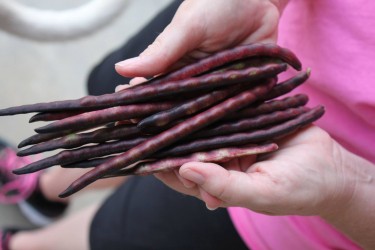Key Ingredients
The true stars of the Southern table are our vegetables.  While fried chicken and barbecue may get more press, vegetables feed the Southern soul. To a child of the South nothing tastes like the sweet potatoes, okra, greens, peas or beans from their native soil.
While fried chicken and barbecue may get more press, vegetables feed the Southern soul. To a child of the South nothing tastes like the sweet potatoes, okra, greens, peas or beans from their native soil.
Whether it is a Mississippi Choctaw transplanted to Chicago, a black Alabama farmer laboring in a Cleveland factory, or an Appalachian college student studying in the Northeast, generations of displaced Southerners have found comfort and connection in these foods of the Southern fields. They remind Southerners of every race, class and creed of who they are and where they come from. The stories of these foods and the connections they forge between people and place will be at the heart of .jpg) our film, At the Common Table.
our film, At the Common Table.
Southern cuisine like most peasant cuisines across the globe is plant based. From the first meetings of Native Americans, Europeans and Africans, inhabitants shared both plants to grow and ways to eat them. The result was an unprecedented wealth of variety. Through this trading of seeds and know how— Native Americans, Africans and Europeans — transformed the landscape as well as one another, forging a uniquely American culture.
The story of four steadfast residents of Southern tables—corn, field peas, sweet potatoes and greens—will underscore how deeply connected Southern people are to the landscape and to one another.
 1. Corn: Without corn there would be no Southern Cuisine. Cornbread which has a place of honor at every Southern meal is a gift of the South’s first inhabitants. Their horticultural genius developed multiples species of maize from a spindly marsh grass, teosinte, and their generosity taught the new settlers how to use it.
1. Corn: Without corn there would be no Southern Cuisine. Cornbread which has a place of honor at every Southern meal is a gift of the South’s first inhabitants. Their horticultural genius developed multiples species of maize from a spindly marsh grass, teosinte, and their generosity taught the new settlers how to use it.
 2. Field Peas: Field peas, like Indian corn, proved an indispensable part of the Southern diet. This legume brought from Africa with the slave trade provided important nutrients, replenished depleted Southern soils, and could be dried for storage. Peas and cornbread were often all that stood between the South and hunger.
2. Field Peas: Field peas, like Indian corn, proved an indispensable part of the Southern diet. This legume brought from Africa with the slave trade provided important nutrients, replenished depleted Southern soils, and could be dried for storage. Peas and cornbread were often all that stood between the South and hunger.
 3. Sweet Potatoes: Just as small farmers recognized the virtue of the field pea, newly arrived Africans seized on the potential of the New World’s sweet potatoes. In the hands of African cooks, sweet potatoes, like collards, reached their consummate glory. The fleshy tubers were baked, fried , sugared, and stirred into that legendary hero of song as well as table—sweet potato pie.
3. Sweet Potatoes: Just as small farmers recognized the virtue of the field pea, newly arrived Africans seized on the potential of the New World’s sweet potatoes. In the hands of African cooks, sweet potatoes, like collards, reached their consummate glory. The fleshy tubers were baked, fried , sugared, and stirred into that legendary hero of song as well as table—sweet potato pie.
 4. Greens: Southern folks are, and always have been, big eaters of greens. Native Americans first taught the new settlers to comb the woods for fresh leaves to enhance their diets and then adopted collards and turnips into their own garden plots. While some folks may prefer cabbage and turnips, other people are likely to choose collards. And for yet other folks, a “mess of greens” may mean mustard, turnips and collards all mixed up together.
4. Greens: Southern folks are, and always have been, big eaters of greens. Native Americans first taught the new settlers to comb the woods for fresh leaves to enhance their diets and then adopted collards and turnips into their own garden plots. While some folks may prefer cabbage and turnips, other people are likely to choose collards. And for yet other folks, a “mess of greens” may mean mustard, turnips and collards all mixed up together.
These foods also allow us to tell the story of people whootherwise are ignored in our histories. While these earlier generations may have left few written records, they left a wealth of information on their plates and the foods that  they handed down. By looking closely at these stories we will look deep into the story of who we are in the South and how we came to be that way.
they handed down. By looking closely at these stories we will look deep into the story of who we are in the South and how we came to be that way.











